D2C subscription boxes for pets offer personalized, direct-from-brand experiences that enhance customer loyalty and provide tailored product selections suited to individual pet needs. B2B subscription models focus on supplying retailers or veterinary clinics with bulk pet products, streamlining inventory management and enabling businesses to offer curated pet care solutions to their customers. Both approaches leverage subscription convenience but differ significantly in target audience, scalability, and customization options.
Table of Comparison
| Feature | D2C Subscription | B2B Subscription |
|---|---|---|
| Target Audience | Individual Consumers | Businesses and Organizations |
| Order Volume | Low to Medium | High |
| Pricing Model | Fixed or Tiered Pricing | Custom Pricing, Volume Discounts |
| Customer Relationship | Direct Engagement | Account Management and Support |
| Contract Duration | Monthly or Quarterly | Annual or Multi-year |
| Customization | Limited Personalization | High Customization |
| Marketing Channels | Social Media, Email, Influencers | Industry Events, Direct Sales |
| Inventory Management | Standard Stock | Bulk and Just-in-Time |
| Payment Terms | Prepaid or Subscription Fees | Net Payment Terms (30-90 days) |
| Examples | Beauty Boxes, Snack Subscriptions | Office Supplies, Software Licenses |
Understanding D2C and B2B Subscription Models
D2C subscription models emphasize direct consumer engagement, personalized experiences, and data-driven marketing strategies to enhance customer loyalty and lifetime value. B2B subscription models focus on scalable service delivery, long-term contracts, and customized solutions tailored to business needs and operational efficiencies. Understanding these distinctions allows companies to optimize revenue streams by aligning product offerings and communication strategies with the unique expectations of each market segment.
Key Differences Between D2C and B2B Subscription Boxes
D2C subscription boxes target individual consumers, emphasizing personalized experiences, convenience, and brand engagement through curated products tailored to personal preferences. B2B subscription boxes serve businesses by providing bulk, industry-specific supplies or samples designed to support professional needs, streamline procurement, and enhance corporate relationships. Key differences lie in audience focus, purchase decision processes, and scale of product customization and delivery frequency.
Target Audience: Who Are You Selling To?
D2C subscription boxes primarily target individual consumers seeking personalized experiences, convenience, and unique products tailored to their preferences. In contrast, B2B subscription services focus on businesses, offering scalable solutions that enhance employee engagement, client gifting, or corporate needs. Understanding the distinct buying motivations and decision-making processes in each market is crucial for optimizing subscriber acquisition and retention strategies.
Customization and Personalization Approaches
D2C subscription boxes emphasize deep personalization by leveraging consumer data to tailor product selections and experiences directly to individual preferences, boosting customer satisfaction and brand loyalty. B2B subscription models focus on customization through scalable options that align with business needs and workflows, ensuring flexibility while maintaining operational efficiency. Advanced analytics and AI-driven tools enhance both approaches by delivering targeted content and product curation at scale.
Pricing Strategies for D2C vs B2B Subscription Services
Pricing strategies for D2C subscription services often emphasize competitive, transparent rates with flexible tiers to attract individual consumers and encourage recurring purchases. B2B subscription pricing typically involves customized plans based on volume, contract length, and value-added services, reflecting enterprise needs and long-term partnerships. Understanding customer demand and usage patterns is crucial for optimizing price points in both D2C and B2B models, maximizing customer lifetime value and revenue.
Marketing Channels and Customer Acquisition
D2C subscription boxes primarily leverage social media advertising, influencer partnerships, and targeted email campaigns to attract individual consumers, optimizing customer acquisition through personalized and direct engagement. B2B subscription models depend on LinkedIn marketing, industry-specific trade shows, and networking events to connect with business clients, emphasizing relationship-building and long-term contracts. Effective marketing channels align with audience behaviors, maximizing acquisition by addressing distinct decision-making processes in D2C and B2B segments.
Logistics and Fulfillment Considerations
D2C subscription models require streamlined logistics with direct-to-consumer shipping solutions, emphasizing personalized packaging and last-mile delivery efficiency to enhance customer satisfaction. B2B subscription services prioritize bulk shipments, warehouse management, and integration with enterprise inventory systems to ensure timely and accurate order fulfillment. Both models demand robust tracking systems and scalable fulfillment operations to handle varying order volumes and reduce delivery lead times.
Revenue Potential and Growth Opportunities
D2C subscription boxes offer higher revenue potential through direct customer relationships and personalized marketing, enabling brands to capture full profit margins and gather valuable consumer data. B2B subscriptions generate steady, scalable revenue by supplying businesses with bulk products or services, often leading to long-term contracts and reduced customer acquisition costs. Growth opportunities in D2C revolve around expanding customer bases and product diversification, while B2B growth is driven by industry partnerships and increased order volumes.
Challenges and Pain Points in Each Model
D2C subscription models often face challenges related to customer acquisition costs and maintaining subscriber retention amid intense competition. B2B subscriptions encounter pain points such as longer sales cycles, complex contract negotiations, and the need for customizable offerings to meet diverse client requirements. Both models must address logistical complexities, but B2B typically demands more sophisticated support and integration capabilities.
Choosing the Right Subscription Model for Your Business
Choosing the right subscription model depends on your target audience and business goals, with D2C subscriptions providing direct consumer engagement and personalized experiences. B2B subscriptions often focus on bulk services, recurring deliveries, or software access, emphasizing long-term partnerships and predictable revenue streams. Analyzing customer behavior, order frequency, and market demand ensures optimal scalability and profitability in either model.
D2C vs B2B subscription Infographic

 bizdif.com
bizdif.com